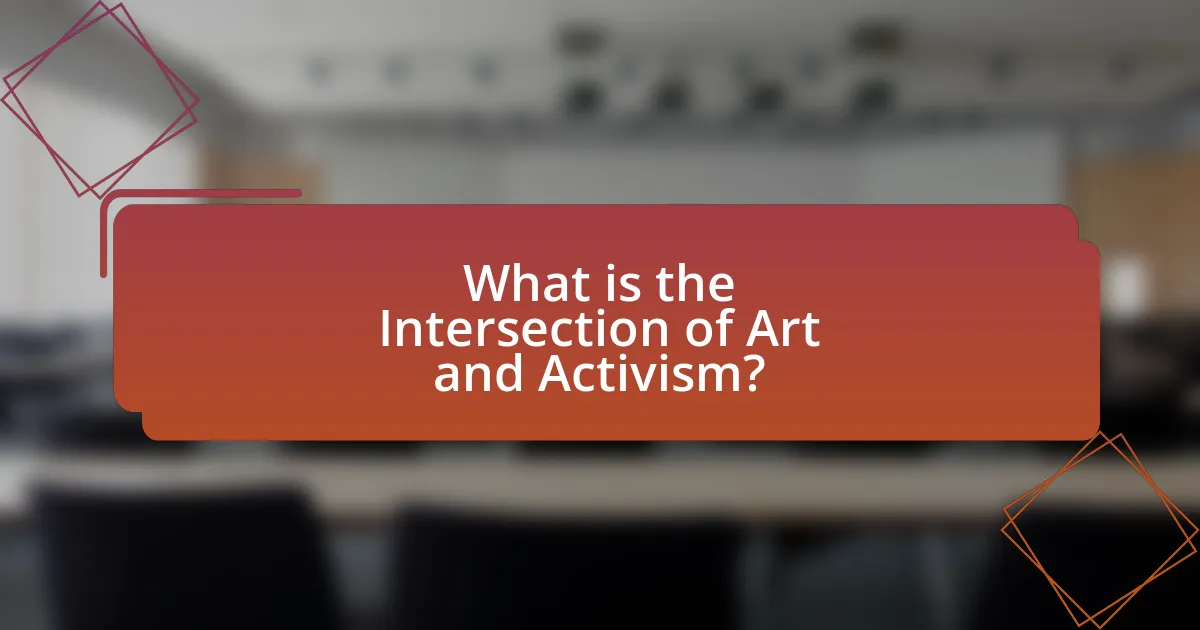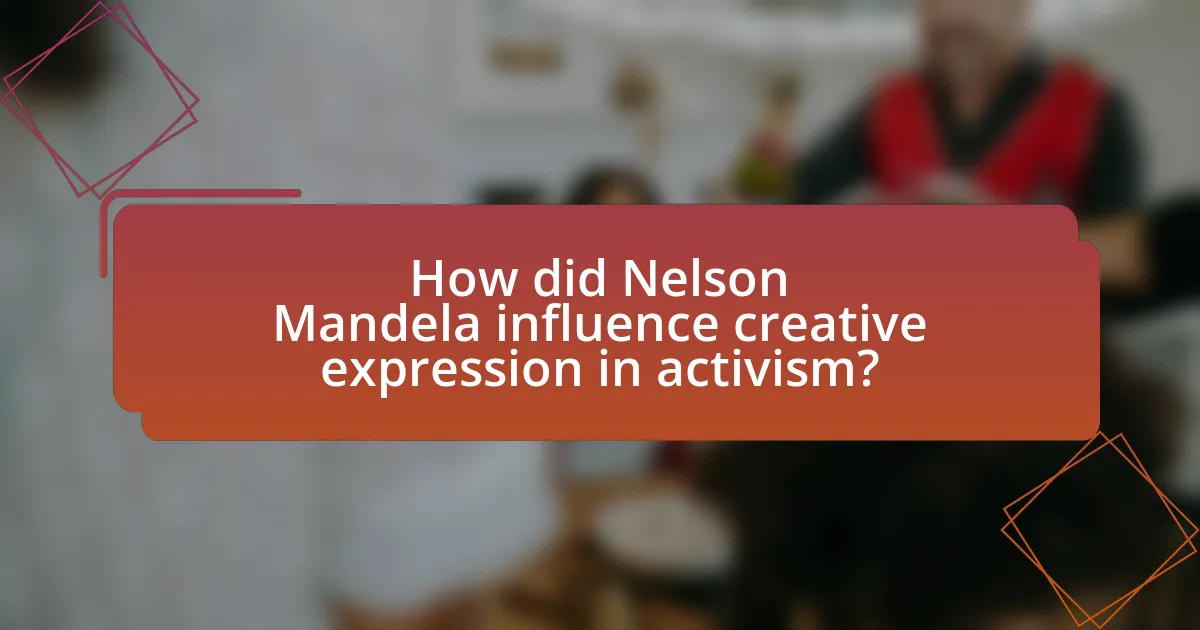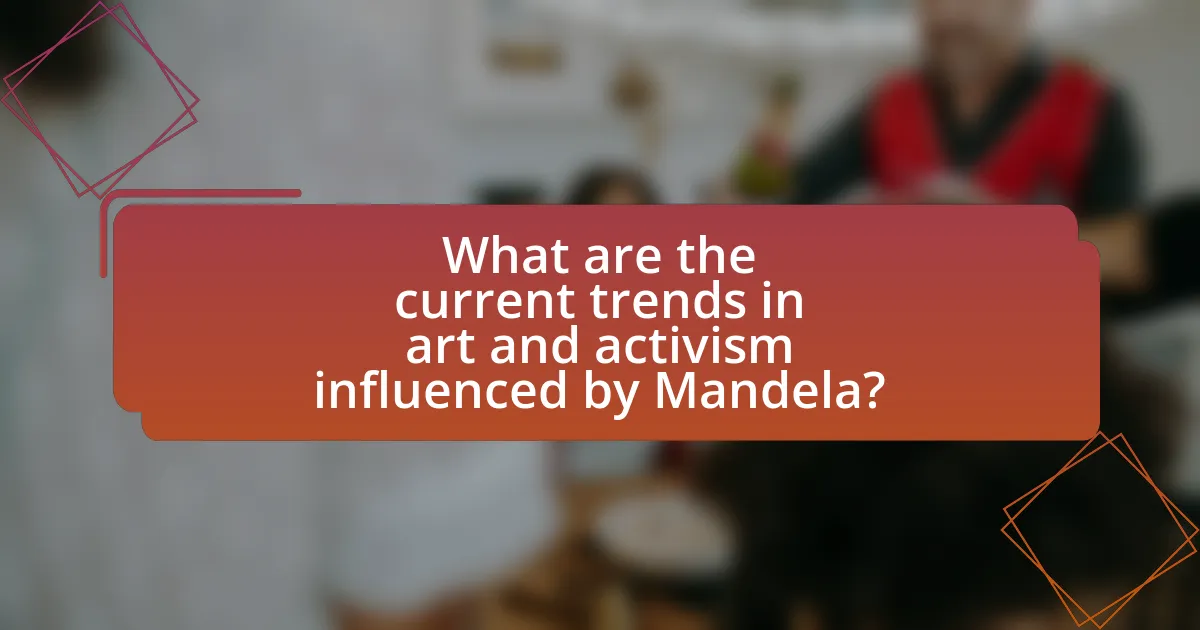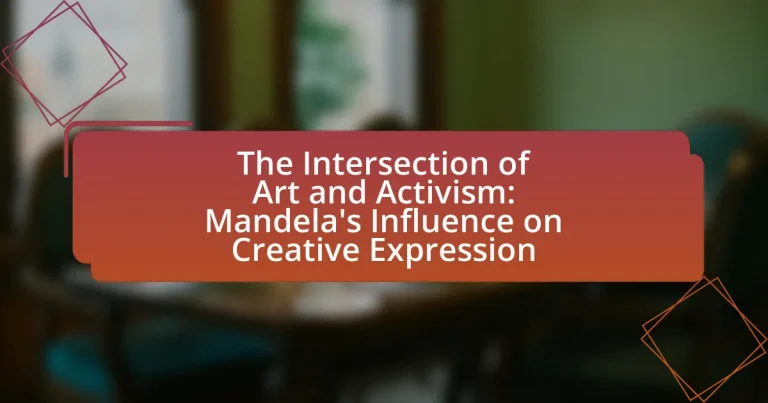The main entity of the article is the intersection of art and activism, with a specific focus on Nelson Mandela’s influence on creative expression. The article explores how art has historically served as a tool for activism, addressing social injustices and inspiring change through various mediums. It highlights key examples of art movements that have influenced activism, the methods artists use to convey political messages, and the significance of this intersection in contemporary society. Additionally, it discusses Mandela’s impact on global art activism, current trends in art and activism, and practical strategies for artists to engage in social justice issues.

What is the Intersection of Art and Activism?
The intersection of art and activism is the convergence where creative expression serves as a tool for social change and political engagement. This relationship has historically enabled artists to address social injustices, raise awareness, and inspire action through various mediums such as visual arts, music, and literature. For instance, during the anti-apartheid movement in South Africa, artists like Nelson Mandela used their platforms to challenge oppressive systems and mobilize communities, demonstrating how art can amplify activist messages and foster collective identity. This synergy between art and activism continues to be evident in contemporary movements, where artists leverage their work to advocate for issues like climate change, racial equality, and human rights, thereby reinforcing the notion that art is not only a reflection of society but also a catalyst for transformation.
How has art historically been used as a form of activism?
Art has historically been used as a form of activism to challenge social injustices and inspire change. Throughout history, artists have employed various mediums, such as painting, music, and literature, to convey powerful messages against oppression and inequality. For instance, during the Civil Rights Movement in the United States, artists like Nina Simone and James Baldwin used their work to highlight racial discrimination and advocate for equality. Similarly, the anti-apartheid movement in South Africa saw artists like Miriam Makeba and the visual art collective “The Black Consciousness Movement” utilize their platforms to raise awareness and mobilize support against apartheid policies. These examples illustrate how art serves as a catalyst for social change, fostering dialogue and encouraging collective action.
What are some key examples of art movements that have influenced activism?
Key examples of art movements that have influenced activism include Dadaism, Surrealism, and the Harlem Renaissance. Dadaism emerged in the early 20th century as a reaction to World War I, using absurdity and anti-art sentiments to challenge societal norms and provoke political thought. Surrealism, which followed, sought to explore the unconscious mind and often critiqued capitalism and war, influencing various social movements. The Harlem Renaissance, occurring in the 1920s, celebrated African American culture and identity, using art and literature to advocate for civil rights and social justice. Each of these movements utilized creative expression to address and challenge prevailing social issues, demonstrating the powerful role of art in activism.
How do artists convey political messages through their work?
Artists convey political messages through their work by utilizing symbolism, visual imagery, and thematic content that reflect social issues and injustices. For instance, artists like Pablo Picasso in “Guernica” used stark imagery to protest the horrors of war, while contemporary street artists like Banksy employ satire and irony to critique political systems. These methods allow artists to engage audiences emotionally and provoke thought, often leading to public discourse and awareness. Historical examples, such as the use of art during the Civil Rights Movement, demonstrate how visual expression can mobilize communities and inspire change, reinforcing the power of art as a tool for activism.
Why is the intersection of art and activism significant in society?
The intersection of art and activism is significant in society because it serves as a powerful medium for social change and awareness. Art has the ability to convey complex messages and emotions, making it an effective tool for activists to communicate their causes. For instance, during the anti-apartheid movement, artists like Nelson Mandela used creative expression to highlight injustices and mobilize support, demonstrating how art can inspire collective action. This synergy not only raises awareness but also fosters empathy and understanding among diverse audiences, ultimately driving societal transformation.
What role does art play in raising awareness about social issues?
Art serves as a powerful medium for raising awareness about social issues by conveying complex messages and emotions that resonate with audiences. Through visual art, music, literature, and performance, artists can highlight injustices, provoke thought, and inspire action. For instance, the works of artists like Ai Weiwei and Banksy have effectively brought attention to issues such as human rights violations and political corruption, often reaching a global audience. Studies show that art can evoke empathy and foster dialogue, making it a crucial tool in social movements, as seen during the anti-apartheid struggle in South Africa, where artists used their creativity to challenge the status quo and mobilize support for change.
How can art inspire change and mobilize communities?
Art can inspire change and mobilize communities by serving as a powerful medium for expression and communication that resonates with collective experiences. Through visual art, music, theater, and literature, artists can highlight social injustices, evoke emotional responses, and foster a sense of solidarity among individuals. For instance, the anti-apartheid movement in South Africa utilized art to raise awareness and galvanize support, with figures like Nelson Mandela emphasizing the role of creative expression in advocating for human rights. This historical context illustrates how art can effectively mobilize communities by uniting them around a common cause, ultimately leading to social transformation.

How did Nelson Mandela influence creative expression in activism?
Nelson Mandela significantly influenced creative expression in activism by promoting the use of art as a means of resistance and social change. His leadership during the anti-apartheid movement encouraged artists, musicians, and writers to use their talents to convey messages of freedom, equality, and justice. For instance, Mandela’s imprisonment inspired numerous songs, poems, and visual art that highlighted the struggle against apartheid, such as the famous song “Free Nelson Mandela” by the Special AKA, which became an anthem for the movement. This cultural output not only galvanized support for the anti-apartheid cause but also demonstrated how creative expression could serve as a powerful tool for activism, fostering solidarity and raising awareness on a global scale.
What artistic movements were inspired by Mandela’s legacy?
Mandela’s legacy inspired several artistic movements, notably the anti-apartheid art movement, which utilized visual arts, music, and literature to protest racial injustice in South Africa. This movement included prominent figures such as artists like William Kentridge and musicians like Hugh Masekela, who expressed resistance through their work. Additionally, the global human rights art movement drew on Mandela’s principles, promoting themes of freedom and equality across various artistic disciplines. The impact of Mandela’s legacy is evident in the way these movements fostered a dialogue about social justice and human rights, influencing artists worldwide to address similar issues in their own contexts.
How did Mandela’s imprisonment influence artists and their work?
Mandela’s imprisonment significantly influenced artists and their work by inspiring a global movement for social justice and freedom. His unjust incarceration became a powerful symbol of the struggle against apartheid, prompting artists to create works that highlighted themes of resistance, resilience, and human rights. For instance, musicians like Hugh Masekela and artists such as Keith Haring produced pieces that directly addressed the injustices of apartheid and called for Mandela’s release. This artistic response not only raised awareness but also mobilized international support, exemplified by the “Free Nelson Mandela” campaign, which became a rallying cry for activists worldwide. The impact of Mandela’s imprisonment thus catalyzed a rich body of art that served both as a form of protest and a means of fostering solidarity among oppressed communities.
What themes in art reflect Mandela’s ideals and struggles?
Themes in art that reflect Mandela’s ideals and struggles include freedom, resilience, and social justice. These themes are evident in various artistic expressions that depict the fight against apartheid, the quest for equality, and the celebration of human dignity. For instance, works by artists like William Kentridge and Esther Mahlangu illustrate the harsh realities of oppression while also conveying hope and the possibility of change, aligning with Mandela’s vision for a united South Africa. Additionally, the use of vibrant colors and powerful imagery in murals and sculptures serves to inspire activism and solidarity, reinforcing Mandela’s legacy as a symbol of resistance and reconciliation.
In what ways did Mandela’s activism shape contemporary art?
Mandela’s activism significantly shaped contemporary art by inspiring artists to address social justice, human rights, and anti-colonial themes. His fight against apartheid and advocacy for equality motivated artists globally to use their work as a platform for political expression and resistance. For instance, the rise of protest art in the 1980s, particularly in South Africa, was directly influenced by Mandela’s leadership and the broader anti-apartheid movement, leading to the creation of powerful visual statements that challenged oppression. Additionally, Mandela’s emphasis on reconciliation and unity has encouraged contemporary artists to explore themes of healing and collective identity, as seen in works that reflect on the legacy of apartheid and the ongoing struggles for justice.
How do modern artists incorporate Mandela’s message into their work?
Modern artists incorporate Mandela’s message into their work by emphasizing themes of social justice, equality, and resilience. For instance, artists like William Kentridge use animation and installation to explore the complexities of apartheid and the struggle for freedom, reflecting Mandela’s fight against oppression. Additionally, street artists such as Banksy have created pieces that resonate with Mandela’s ideals, often addressing issues of human rights and systemic inequality. These artistic expressions serve to inspire activism and provoke dialogue, aligning with Mandela’s legacy of promoting peace and reconciliation.
What impact has Mandela’s influence had on global art activism?
Nelson Mandela’s influence has significantly shaped global art activism by inspiring artists to use their work as a tool for social change and justice. His commitment to human rights and equality resonated worldwide, prompting artists to address issues such as apartheid, racism, and oppression through various forms of creative expression. For instance, the “Free Nelson Mandela” campaign became a rallying cry for artists, leading to the creation of powerful works that highlighted the struggle against apartheid, such as the iconic song “Free Nelson Mandela” by The Special A.K.A. This song not only raised awareness but also mobilized international support for the anti-apartheid movement. Furthermore, Mandela’s legacy continues to inspire contemporary artists who engage in activism, as seen in exhibitions and projects that advocate for social justice, reflecting his enduring impact on the intersection of art and activism globally.

What are the current trends in art and activism influenced by Mandela?
Current trends in art and activism influenced by Nelson Mandela emphasize social justice, human rights, and community empowerment. Artists are increasingly using their platforms to address systemic inequalities and advocate for marginalized voices, reflecting Mandela’s legacy of fighting against oppression. For instance, contemporary murals and installations often depict themes of resilience and unity, inspired by Mandela’s struggle against apartheid. Additionally, collaborative art projects that engage local communities are gaining traction, fostering dialogue and collective action, which aligns with Mandela’s belief in the power of community involvement for social change.
How are artists today addressing social justice issues through their work?
Artists today are addressing social justice issues through their work by using various mediums to raise awareness, provoke thought, and inspire action. For instance, visual artists create powerful imagery that highlights systemic inequalities, while musicians compose songs that reflect the struggles of marginalized communities. A notable example is the use of street art, which has become a prominent form of protest, as seen in the murals created during the Black Lives Matter movement, where artists like Shepard Fairey and Banksy have contributed pieces that challenge racial injustice. Additionally, performance art has been utilized to engage audiences in conversations about social issues, exemplified by artists such as Marina Abramović, who explores themes of identity and oppression. These artistic expressions not only communicate urgent social messages but also mobilize communities, demonstrating the significant role of art in activism.
What mediums are most effective for conveying activist messages in art?
Visual art, particularly painting, murals, and photography, are the most effective mediums for conveying activist messages in art. These forms allow for immediate visual impact and emotional resonance, making complex social issues accessible to a broad audience. For instance, the use of murals in urban spaces has historically served as a powerful tool for community expression and social commentary, exemplified by the murals in the South African townships during the anti-apartheid movement, which communicated resistance and hope. Additionally, photography has played a crucial role in documenting social injustices, as seen in the works of photojournalists who captured pivotal moments in civil rights movements, effectively raising awareness and prompting action.
How do collaborations between artists and activists enhance creative expression?
Collaborations between artists and activists enhance creative expression by merging artistic innovation with social advocacy, resulting in powerful narratives that resonate with audiences. This synergy allows artists to convey complex social issues through various mediums, while activists gain a platform to amplify their messages. For instance, the collaboration between visual artists and social movements, such as the Black Lives Matter movement, has led to impactful murals and installations that communicate urgency and emotion, effectively engaging the public. Historical examples, like the work of artists during the anti-apartheid movement in South Africa, demonstrate how art can mobilize communities and inspire change, showcasing the profound impact of these collaborations on both creative expression and social justice.
What practical strategies can artists use to engage in activism?
Artists can engage in activism by using their creative platforms to raise awareness, provoke thought, and inspire action on social issues. They can create art that reflects societal challenges, such as inequality or injustice, thereby fostering dialogue and encouraging community engagement. For instance, street art and murals have historically served as powerful tools for social commentary, as seen in the works of artists like Banksy, who address political and social issues through provocative imagery. Additionally, artists can collaborate with activist organizations to amplify their messages, participate in community events, and use social media to reach wider audiences, effectively mobilizing support for various causes. This approach not only enhances visibility for the issues at hand but also builds a sense of solidarity among diverse groups.
How can artists effectively communicate their messages to a broader audience?
Artists can effectively communicate their messages to a broader audience by utilizing diverse platforms and engaging storytelling techniques. By leveraging social media, artists can reach millions instantly; for example, platforms like Instagram and TikTok allow for visual storytelling that resonates with younger demographics. Additionally, incorporating elements of cultural relevance and historical context, as seen in the works inspired by Nelson Mandela, can deepen the impact of their messages. Research indicates that art that reflects social issues can foster empathy and understanding, making it more relatable to a wider audience. This approach not only amplifies their voice but also encourages dialogue and action around the issues they address.
What resources are available for artists looking to combine art and activism?
Artists looking to combine art and activism can access various resources, including grants, workshops, and collaborative platforms. Organizations such as the Art for Justice Fund provide financial support for projects that address social justice issues through art. Additionally, platforms like Creative Capital offer professional development resources and funding opportunities specifically for artists engaged in activism. Workshops and training programs, such as those offered by the Center for Artistic Activism, equip artists with skills to effectively merge their creative practices with advocacy efforts. These resources collectively empower artists to create impactful work that promotes social change.




